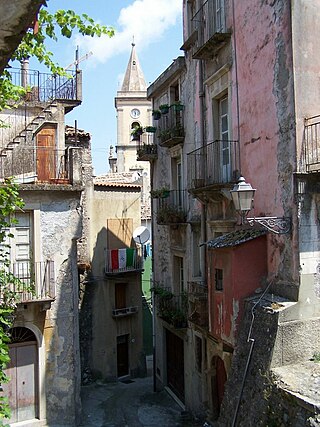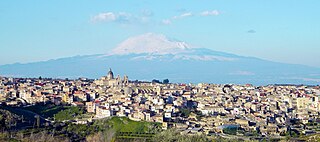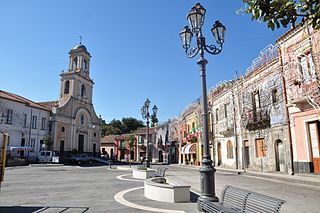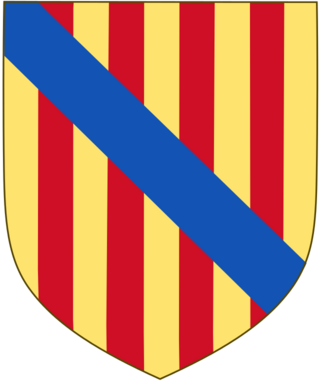
Sicily is an island in the central Mediterranean Sea, south of the Italian Peninsula in continental Europe and is one of the 20 regions of Italy. With 4.8 million inhabitants, including 1.3 million in and around the capital city of Palermo, it is the most populous island in the Mediterranean Sea. It is named after the Sicels, who inhabited the eastern part of the island during the Iron Age. Sicily has a rich and unique culture in arts, music, literature, cuisine, and architecture. Its most prominent landmark is Mount Etna, the tallest active volcano in Europe, and one of the most active in the world, currently 3,357 m (11,014 ft) high. The island has a typical Mediterranean climate. It is separated from Calabria by the Strait of Messina. It is one of the five Italian autonomous regions and is generally considered part of Southern Italy.

Catania is the second-largest municipality in Sicily, after Palermo, both by area and by population. Despite its reputation as the second city of the island, Catania is the largest Sicilian conurbation, and among the largest in Italy. It has important road and rail transport infrastructures, and hosts the main airport in Sicily. The city is located on Sicily's east coast, facing the Ionian Sea at the base of the active volcano Mount Etna. It is the capital of the 58-municipality region known as the Metropolitan City of Catania, which is the seventh-largest metropolitan area in Italy. The population of the city proper is 311,584, while the population of the Metropolitan City of Catania is 1,107,702.

Noto is a city and comune in the Province of Syracuse, Sicily, Italy. It is 32 kilometres (20 mi) southwest of the city of Syracuse at the foot of the Iblean Mountains. It lends its name to the surrounding area Val di Noto. In 2002 Noto and its church were declared a UNESCO World Heritage Site.

Agathaof Sicily is a Christian saint. Her feast is on 5 February. Agatha was born in Catania, part of the Roman Province of Sicily, and was martyred c. 251. She is one of several virgin martyrs who are commemorated by name in the Canon of the Mass.

Caltagirone is an inland city and municipality in the Metropolitan City of Catania, on the island of Sicily, Southern Italy, about 70 kilometres (43 mi) southwest of Catania.

Francavilla di Sicilia is a town and comune in the Metropolitan City of Messina on the island of Sicily, southern Italy.

Fiumefreddo di Sicilia is a comune in the Metropolitan City of Catania on the coast of the Ionian Sea on the island of Sicily, southern Italy. It shares its borders with the municipalities of Calatabiano to the north, Mascali to the south and Piedimonte Etneo to the west.

Novara di Sicilia is a comune (municipality) in the Metropolitan City of Messina in the Italian region of Sicily, located about 160 kilometres (99 mi) east of Palermo and some 40 kilometres (25 mi) southwest of Messina.

Sambuca di Sicilia is a comune (municipality) in the Province of Agrigento in the Italian region Sicily, located about 68 kilometres (42 mi) southwest of Palermo and about 89 kilometres (55 mi) northwest of Agrigento. It is one of I Borghi più belli d'Italia.

Castiglione di Sicilia is a comune (municipality) in the Metropolitan City of Catania in Sicily, southern Italy. It is one of I Borghi più belli d'Italia.

Militello in Val di Catania is a comune (municipality) in the Metropolitan City of Catania in the Italian region Sicily, located about 160 kilometres (99 mi) southeast of Palermo and about 35 kilometres (22 mi) southwest of Catania, on the last slopes of the Hyblaean Mountains. It has a railway station on the line Catania-Gela. It is one of I Borghi più belli d'Italia.

Piedimonte Etneo is a comune (municipality) in the Metropolitan City of Catania in the Italian region Sicily, located about 160 kilometres (99 mi) east of Palermo and about 35 kilometres (22 mi) northeast of Catania.
Siculo-Arabic or Sicilian Arabic is the term used for varieties of Arabic that were spoken in the Emirate of Sicily from the 9th century, persisting under the subsequent Norman rule until the 13th century. It was derived from Arabic following the Abbasid conquest of Sicily in the 9th century and gradually marginalized following the Norman conquest in the 11th century.

Lentini is a town and comune in the Province of Syracuse, southeastern Sicily, located 35 km north-west of Syracuse.

The Metropolitan City of Catania is a metropolitan city in Sicily, southern Italy. Its capital is the city of Catania. It replaced the province of Catania and comprises the city of Catania and other 57 comuni.
The following is a timeline of the history of the city of Catania in the Sicily region of Italy.

The House of Gravina, then Gravina Cruyllas, was a noble family of Norman origins, with roots stretching back to Rollo, the first ruler of Normandy.

Asmundo is an old Sicilian noble family that has played a notable role in the island's political, cultural, and economic history.

Simone De Wobreck was a 16th-century Flemish painter, whose known works all come from his long period in Sicily.

The House of Paternò is a Sicilian princely family, among the most important and ancient of the Italian aristocracy. Founded in the 11th century, it is one of the four Sicilian families with more than 1000 years of history. The Paternò family also has a particular ancestry, originating from three sovereign and royal houses. Through the male line, and according to tradition, it is a cadet branch from the sovereign house of Barcelona. Through the female line, however, it comes from the Altavillas and, presumably, also from the Provenzas. These ancestries allow the Paternòs to date back to before the 8th century.





















